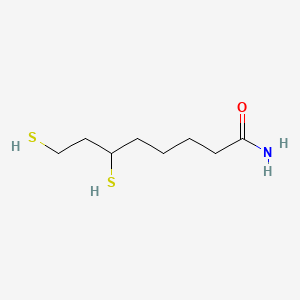| MeSH term | MeSH ID | Detail |
|---|---|---|
| Parkinsonian Disorders | D020734 | 20 associated lipids |
Dihydrolipoamide
Dihydrolipoamide is a lipid of Fatty Acyls (FA) class. Dihydrolipoamide is associated with abnormalities such as Wiskott-Aldrich Syndrome. The involved functions are known as Citric Acid Cycle, Electron Transport, NADH oxidation, Oxidation and Oxidants. Dihydrolipoamide often locates in Mitochondria, Mitochondrial matrix and Chloroplasts. The associated genes with Dihydrolipoamide are Mutant Proteins, Recombinant Proteins, mycothione reductase, Genes, Mitochondrial and alanylproline.
Cross Reference
Introduction
To understand associated biological information of Dihydrolipoamide, we collected biological information of abnormalities, associated pathways, cellular/molecular locations, biological functions, related genes/proteins, lipids and common seen animal/experimental models with organized paragraphs from literatures.
What diseases are associated with Dihydrolipoamide?
Dihydrolipoamide is suspected in and other diseases in descending order of the highest number of associated sentences.
Related references are mostly published in these journals:
| Disease | Cross reference | Weighted score | Related literature |
|---|
Possible diseases from mapped MeSH terms on references
We collected disease MeSH terms mapped to the references associated with Dihydrolipoamide
PubChem Associated disorders and diseases
What pathways are associated with Dihydrolipoamide
There are no associated biomedical information in the current reference collection.
PubChem Biomolecular Interactions and Pathways
Link to PubChem Biomolecular Interactions and PathwaysWhat cellular locations are associated with Dihydrolipoamide?
Visualization in cellular structure
Associated locations are in red color. Not associated locations are in black.
Related references are published most in these journals:
| Location | Cross reference | Weighted score | Related literatures |
|---|
What functions are associated with Dihydrolipoamide?
Related references are published most in these journals:
| Function | Cross reference | Weighted score | Related literatures |
|---|
What lipids are associated with Dihydrolipoamide?
There are no associated biomedical information in the current reference collection.
What genes are associated with Dihydrolipoamide?
Related references are published most in these journals:
| Gene | Cross reference | Weighted score | Related literatures |
|---|
What common seen animal models are associated with Dihydrolipoamide?
There are no associated biomedical information in the current reference collection.
NCBI Entrez Crosslinks
All references with Dihydrolipoamide
Download all related citations| Authors | Title | Published | Journal | PubMed Link |
|---|---|---|---|---|
| Xue F et al. | Transcriptional responses of Leptospira interrogans to host innate immunity: significant changes in metabolism, oxygen tolerance, and outer membrane. | 2010 | PLoS Negl Trop Dis | pmid:21049008 |
| Pang S et al. | Regulation of fasting fuel metabolism by toll-like receptor 4. | 2010 | Diabetes | pmid:20855545 |
| Dozot M et al. | Functional characterization of the incomplete phosphotransferase system (PTS) of the intracellular pathogen Brucella melitensis. | 2010 | PLoS ONE | pmid:20844759 |
| He M et al. | Characterization and genomic analysis of chromate resistant and reducing Bacillus cereus strain SJ1. | 2010 | BMC Microbiol. | pmid:20723231 |
| Kim SY and Kim J | Roles of dihydrolipoamide dehydrogenase Lpd1 in Candida albicans filamentation. | 2010 | Fungal Genet. Biol. | pmid:20601046 |
| Shen CJ et al. | Proteomic identification of membrane proteins regulating antimicrobial peptide resistance in Vibrio parahaemolyticus. | 2010 | J. Appl. Microbiol. | pmid:19796120 |
| Sastalla I et al. | Activation of the latent PlcR regulon in Bacillus anthracis. | 2010 | Microbiology (Reading, Engl.) | pmid:20688829 |
| Castro H et al. | Mitochondrial redox metabolism in trypanosomatids is independent of tryparedoxin activity. | 2010 | PLoS ONE | pmid:20838623 |
| Trofimova L et al. | Behavioral impact of the regulation of the brain 2-oxoglutarate dehydrogenase complex by synthetic phosphonate analog of 2-oxoglutarate: implications into the role of the complex in neurodegenerative diseases. | 2010 | Int J Alzheimers Dis | pmid:21049004 |
| Gerards M et al. | Defective complex I assembly due to C20orf7 mutations as a new cause of Leigh syndrome. | 2010 | J. Med. Genet. | pmid:19542079 |
| Peplinski K et al. | Investigations on the microbial catabolism of the organic sulfur compounds TDP and DTDP in Ralstonia eutropha H16 employing DNA microarrays. | 2010 | Appl. Microbiol. Biotechnol. | pmid:20924576 |
| Bruant G et al. | Genomic analysis of carbon monoxide utilization and butanol production by Clostridium carboxidivorans strain P7. | 2010 | PLoS ONE | pmid:20885952 |
| Ajith VK and Prasad R | A novel protein that binds to dnrN-dnrO intergenic region of Streptomyces peucetius purified by DNA affinity capture has dihydrolipoamide dehydrogenase activity. | 2009 | Protein Expr. Purif. | pmid:19481152 |
| Kurakin A | Scale-free flow of life: on the biology, economics, and physics of the cell. | 2009 | Theor Biol Med Model | pmid:19416527 |
| Günther S et al. | Knockout studies reveal an important role of Plasmodium lipoic acid protein ligase A1 for asexual blood stage parasite survival. | 2009 | PLoS ONE | pmid:19434237 |
| Ambrus A et al. | Inhibition of the alpha-ketoglutarate dehydrogenase-mediated reactive oxygen species generation by lipoic acid. | 2009 | J. Neurochem. | pmid:19393031 |
| Stern JM et al. | Radiofrequency ablation of small renal cortical tumours in healthy adults: renal function preservation and intermediate oncological outcome. | 2009 | BJU Int. | pmid:19426196 |
| Marino SM and Gladyshev VN | A structure-based approach for detection of thiol oxidoreductases and their catalytic redox-active cysteine residues. | 2009 | PLoS Comput. Biol. | pmid:19424433 |
| White JR et al. | Statistical methods for detecting differentially abundant features in clinical metagenomic samples. | 2009 | PLoS Comput. Biol. | pmid:19360128 |
| Tyagi TK et al. | Moonlighting protein in Starkeyomyces koorchalomoides: characterization of dihydrolipoamide dehydrogenase as a protein acetyltransferase utilizing acetoxycoumarin as the acetyl group donor. | 2009 | Biochimie | pmid:19383527 |
